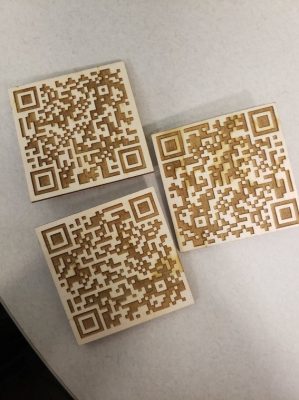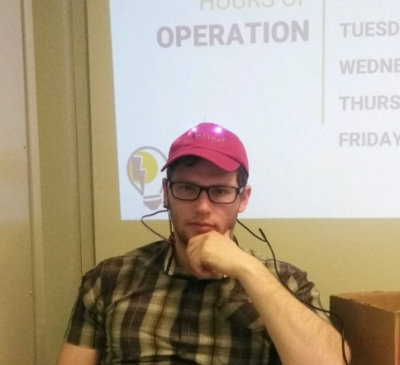 The goal of our project was to implement a score system for Convention Nation, a company that recommends conventions to its users. Scores would be assigned based on level of engagement with Convention Nation’s social media presence. This project combined the principles of gamification with a range of technologies offered at OPIM Innovate. We incorporated IOT in the form of a device that displays Facebook data, AI in the form of sentiment analysis and AR in the form of Splunk’s AR workspaces.
The goal of our project was to implement a score system for Convention Nation, a company that recommends conventions to its users. Scores would be assigned based on level of engagement with Convention Nation’s social media presence. This project combined the principles of gamification with a range of technologies offered at OPIM Innovate. We incorporated IOT in the form of a device that displays Facebook data, AI in the form of sentiment analysis and AR in the form of Splunk’s AR workspaces.
We were able to take data from Facebook using the Graph Application Programming Interface. We then used Natural Language Toolkit, a platform for working with natural language data in Python, to perform sentiment analysis on Facebook comments. For our presentation, we created a Facebook page that visitors could interact with and assigned scores to the administrators of the page. As each page admin made posts and visitors made comments on them, scores changed based on the level of constructive engagement. Splunk, a data analytics platform, provided a series of tools that could be used to view trends in the data and display it in augmented reality. I designed laser cut QR code lapel pins using the laser cutter at the Maker Studio in the library. The Splunk AR workspaces allowed us to scan the pins with an iPad and see our engagement scores appear next to us.
By: Eli Udler
 Wearable biometric technology is currently revolutionizing healthcare and consumer electronics. Internet-enabled pacemakers, smart watches with heart rate sensors and all manner of medical equipment now merge health with convenience. This is all a step in the right direction, but not quite the end goal. In fact, it seems that we’re past the point where technology can fix all the problems we’ve created. If this is the case then, at the very least, I think we can have a bit of fun while we’re still alive. Let us not mince words: We’re headed straight for a global environmental collapse, and I propose we go out in style.
Wearable biometric technology is currently revolutionizing healthcare and consumer electronics. Internet-enabled pacemakers, smart watches with heart rate sensors and all manner of medical equipment now merge health with convenience. This is all a step in the right direction, but not quite the end goal. In fact, it seems that we’re past the point where technology can fix all the problems we’ve created. If this is the case then, at the very least, I think we can have a bit of fun while we’re still alive. Let us not mince words: We’re headed straight for a global environmental collapse, and I propose we go out in style. The design of the device is relatively simple. I used the FLORA (a wearable, Arduino-compatible microcontroller) as the brain of the device, a Pulse Sensor to read heart rate data from the user’s ear lobe and several NeoPixel LED sequins for output. The speed at which the LEDs blink is determined by heart rate and the color is determined by heart rate variance. In the process of designing this, I learned how to work with conductive thread, how to program addressable LEDs and how to read and interpret heart rate and heart variance data from a sensor. As these are all important skills for wearable electronics prototyping, a similar project may be viable as an introduction to wearable product design. Going forward, I would like to explore other options for visualizing output from biometric sensors. I may work on outputting data from such a device to a computer via Bluetooth, incorporate additional sensors into the design and log the data to be used for analysis.
The design of the device is relatively simple. I used the FLORA (a wearable, Arduino-compatible microcontroller) as the brain of the device, a Pulse Sensor to read heart rate data from the user’s ear lobe and several NeoPixel LED sequins for output. The speed at which the LEDs blink is determined by heart rate and the color is determined by heart rate variance. In the process of designing this, I learned how to work with conductive thread, how to program addressable LEDs and how to read and interpret heart rate and heart variance data from a sensor. As these are all important skills for wearable electronics prototyping, a similar project may be viable as an introduction to wearable product design. Going forward, I would like to explore other options for visualizing output from biometric sensors. I may work on outputting data from such a device to a computer via Bluetooth, incorporate additional sensors into the design and log the data to be used for analysis. I was excited to find out that a Writing Center tutor was kind enough to donate a Keurig to the office, putting lifegiving caffeine in the hands of tutors without the cost of running down to Bookworms Cafe. Alas, it was disturbing to see that the K-Cups used by the machine were being stored in a small basket. Now, I’m not the Queen of England or anything, but I have my limits. The toll on my mental health taken by watching the cups lazily thrown into a pile in the woven container was enough to force me to take action. With less than half an hour of active work, I was able to turn the Writing Center logo, a stylized “W”, into a three-dimensional model complete with holes designed to hold K-Cups.
I was excited to find out that a Writing Center tutor was kind enough to donate a Keurig to the office, putting lifegiving caffeine in the hands of tutors without the cost of running down to Bookworms Cafe. Alas, it was disturbing to see that the K-Cups used by the machine were being stored in a small basket. Now, I’m not the Queen of England or anything, but I have my limits. The toll on my mental health taken by watching the cups lazily thrown into a pile in the woven container was enough to force me to take action. With less than half an hour of active work, I was able to turn the Writing Center logo, a stylized “W”, into a three-dimensional model complete with holes designed to hold K-Cups. But there’s another reason I decided to turn my strange idea into a reality: I wanted to highlight the range of resources offered on campus to UConn students. The OPIM Innovate space and the Writing
But there’s another reason I decided to turn my strange idea into a reality: I wanted to highlight the range of resources offered on campus to UConn students. The OPIM Innovate space and the Writing